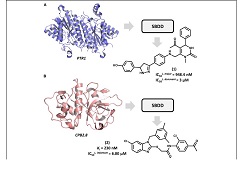Chemoinformatics strategies for leishmaniasis drug discovery.
FERREIRA, Leonardo L. G.; ANDRICOPULO, Adriano Defini.
FERREIRA, Leonardo L. G.; ANDRICOPULO, Adriano Defini.
 Abstract: Leishmaniasis is a fatal neglected tropical disease (NTD) that is caused by more than 20 species of Leishmania parasites. The disease kills approximately 20,000 people each year and more than 1 billion are susceptible to infection. Although counting on a few compounds, the therapeutic arsenal faces some drawbacks such as drug resistance, toxicity issues, high treatment costs, and accessibility problems, which highlight the need for novel treatment options. Worldwide efforts have been made to that aim and, as well as in other therapeutic areas, chemoinformatics have contributed significantly to leishmaniasis drug discovery. Breakthrough advances in the comprehension of the parasites? molecular biology have enabled the design of high-affinity ligands for a number of macromolecular targets. In addition, the use of chemoinformatics has allowed highly accurate predictions of biological activity and physicochemical and pharmacokinetics properties of novel antileishmanial compounds. This review puts into perspective the current context of leishmaniasis drug discovery and focuses on the use of chemoinformatics to develop better therapies for this life-threatening condition. Abstract: Leishmaniasis is a fatal neglected tropical disease (NTD) that is caused by more than 20 species of Leishmania parasites. The disease kills approximately 20,000 people each year and more than 1 billion are susceptible to infection. Although counting on a few compounds, the therapeutic arsenal faces some drawbacks such as drug resistance, toxicity issues, high treatment costs, and accessibility problems, which highlight the need for novel treatment options. Worldwide efforts have been made to that aim and, as well as in other therapeutic areas, chemoinformatics have contributed significantly to leishmaniasis drug discovery. Breakthrough advances in the comprehension of the parasites? molecular biology have enabled the design of high-affinity ligands for a number of macromolecular targets. In addition, the use of chemoinformatics has allowed highly accurate predictions of biological activity and physicochemical and pharmacokinetics properties of novel antileishmanial compounds. This review puts into perspective the current context of leishmaniasis drug discovery and focuses on the use of chemoinformatics to develop better therapies for this life-threatening condition. | |
| Frontiers in Pharmacology |
| v. 9, p. 1278-1-1278-11 - Ano: 2018 |
| Fator de Impacto: 3,831 |
| http://dx.doi.org/10.3389/fphar.2018.01278 |  @article={002912041,author = {FERREIRA, Leonardo L. G.; ANDRICOPULO, Adriano Defini.},title={Chemoinformatics strategies for leishmaniasis drug discovery},journal={Frontiers in Pharmacology},note={v. 9, p. 1278-1-1278-11},year={2018}} @article={002912041,author = {FERREIRA, Leonardo L. G.; ANDRICOPULO, Adriano Defini.},title={Chemoinformatics strategies for leishmaniasis drug discovery},journal={Frontiers in Pharmacology},note={v. 9, p. 1278-1-1278-11},year={2018}} |



